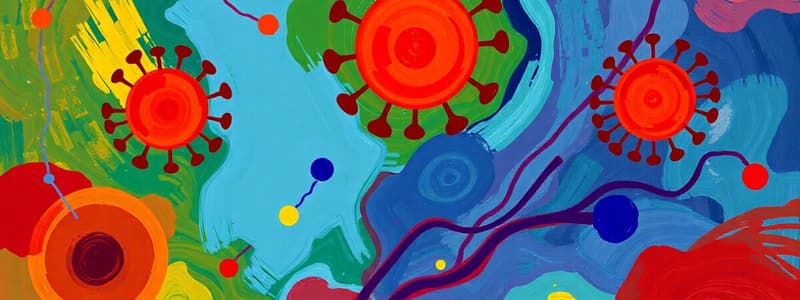Podcast
Questions and Answers
What primarily initiates the activation of the classical pathway in the complement system?
What primarily initiates the activation of the classical pathway in the complement system?
- The interaction between C3b and bacterial membranes
- Infection by viruses
- Binding of lipopolysaccharides to receptor proteins
- Presence of antigen-antibody complexes (correct)
Which of the following roles is NOT associated with activated complement proteins?
Which of the following roles is NOT associated with activated complement proteins?
- Inhibition of inflammation (correct)
- Membrane attack complex formation
- Vasodilation
- Opsonization
Which complement proteins are directly involved in increasing capillary permeability?
Which complement proteins are directly involved in increasing capillary permeability?
- C2 and C3
- C3b, C4, C5
- C5 through C9
- C2a, C3a, C5a (correct)
What is the primary function of the kinin system in inflammation?
What is the primary function of the kinin system in inflammation?
In the context of inflammation, what do the end products of the three plasma protein systems NOT promote?
In the context of inflammation, what do the end products of the three plasma protein systems NOT promote?
Which pathway of the complement system is activated by the binding of mannose-binding lectin?
Which pathway of the complement system is activated by the binding of mannose-binding lectin?
What sequence characterizes the clotting system's response during inflammation?
What sequence characterizes the clotting system's response during inflammation?
What is the primary function of neutrophils during inflammation?
What is the primary function of neutrophils during inflammation?
What triggers monocytes to transform into macrophages?
What triggers monocytes to transform into macrophages?
Which of the following accurately describes EDRF?
Which of the following accurately describes EDRF?
Which white blood cell type primarily engages in the phagocytosis of parasites?
Which white blood cell type primarily engages in the phagocytosis of parasites?
What is the normal percentage range for immature neutrophils in total WBC count?
What is the normal percentage range for immature neutrophils in total WBC count?
Which function is NOT associated with macrophages?
Which function is NOT associated with macrophages?
Which percentage range do eosinophils typically represent in total WBC count?
Which percentage range do eosinophils typically represent in total WBC count?
What role do platelets play in inflammation?
What role do platelets play in inflammation?
How do endothelial cells contribute to the inflammatory process?
How do endothelial cells contribute to the inflammatory process?
What kind of injuries do neutrophils primarily combat?
What kind of injuries do neutrophils primarily combat?
Which chemical do eosinophils release to control inflammation?
Which chemical do eosinophils release to control inflammation?
Which function is NOT associated with fibrin?
Which function is NOT associated with fibrin?
What is the primary role of Bradykinin in the inflammatory process?
What is the primary role of Bradykinin in the inflammatory process?
Which of the following are local manifestations of inflammation?
Which of the following are local manifestations of inflammation?
What primarily increases during leukocytosis in acute inflammation?
What primarily increases during leukocytosis in acute inflammation?
Which substance is a marker for bacterial infection during inflammation?
Which substance is a marker for bacterial infection during inflammation?
What happens to the erythrocyte sedimentation rate (ESR) during acute inflammation?
What happens to the erythrocyte sedimentation rate (ESR) during acute inflammation?
Which of the following is NOT considered an acute phase reactant released by the liver during inflammation?
Which of the following is NOT considered an acute phase reactant released by the liver during inflammation?
Which factor is NOT a trigger for fever in the inflammatory response?
Which factor is NOT a trigger for fever in the inflammatory response?
What is one primary purpose of inflammation in the body?
What is one primary purpose of inflammation in the body?
Which characteristic is NOT associated with the inflammatory response?
Which characteristic is NOT associated with the inflammatory response?
What cells are primarily involved in the inflammatory response?
What cells are primarily involved in the inflammatory response?
What initiates the inflammatory response?
What initiates the inflammatory response?
Which mediator is primarily released by mast cells during inflammation?
Which mediator is primarily released by mast cells during inflammation?
What action do H1 receptors cause in the body?
What action do H1 receptors cause in the body?
What role do neutrophils play in the inflammatory response?
What role do neutrophils play in the inflammatory response?
What plasma protein system is NOT associated with the inflammatory response?
What plasma protein system is NOT associated with the inflammatory response?
Which symptom can be associated with the action of prostaglandins during inflammation?
Which symptom can be associated with the action of prostaglandins during inflammation?
What type of injury initiates the inflammatory response to protect the body?
What type of injury initiates the inflammatory response to protect the body?
Study Notes
Inflammation Purpose
- The primary purpose of inflammation is to eliminate harmful stimuli, such as infectious microorganisms or damaged cells, and to initiate tissue repair.
- Inflammation functions to
- Destroy infectious and injurious organisms
- Wall off the site of infection
- Stimulate and enhance the immune response
- Stimulate tissue healing and provide a framework for tissue repair
### Characteristics of the Inflammatory Response
- Inflammation occurs in vascular tissues.
- It is an immediate and non-specific response.
- Inflammation lacks memory, meaning it does not recognize previous exposures.
- Inflammatory chemicals (mediators) affect both host and non-host cells.
- It is self-limiting, meaning it is a temporary response that resolves once the harmful stimulus is eliminated.
Components of the Inflammatory Response
- The inflammatory response involves three main components:
- Cells:
- White blood cells (WBCs): neutrophils, eosinophils, basophils, lymphocytes, monocytes, and macrophages
- Endothelial cells
- Platelets
- Inflammatory chemicals (mediators):
- Cytokines: IL-1, TNF-alpha, IL-6, IL-8, interferon-gamma
- Vasoactive inflammatory mediators: histamine, serotonin, leukotrienes, prostaglandins
- Anti-inflammatory mediators: Il-10, IL-4, transforming growth factor (TGF)-beta
- Plasma protein systems:
- Complement system
- Clotting system
- Kinin system
- Cells:
Activation of the Inflammatory Response
- Injury to the cell membrane from various sources triggers the inflammatory response:
- Trauma
- Hypoxia
- Myocardial infarction
- Stroke
- Chemical injury
- Aspiration of gastric fluid
- Peptic ulcer disease
- Pancreatitis
- Immune injury
- Autoimmune diseases
- Allergic reactions
- Infections
- Thermal injury (burns)
- Ionizing radiation
Overview of Inflammatory Response to Cell Injury
- Upon cellular injury, the following occur as part of an orchestrated cascade:
- Mast cell degranulation and release of initial vasoactive mediators, including histamine
- White blood cell margination and migration
- Release of cytokines and inflammatory mediators
- Activation of the plasma protein systems
Mast Cell Degranulation and Release of Initial Vasoactive Mediators
- Mast cells play a crucial role in activating the local inflammatory response.
- Mast cells are found in various tissues, especially near blood vessels
- Mast cells are triggered by:
- Local cellular injury
- Endotoxin
- Complement proteins
- Immunologic factors: IgE hypersensitivity
Mast Cell Degranulation and Release of Initial Vasoactive Mediators
- Upon activation, Mast cells release various mediators, including histamine, leukotrienes, and prostaglandins
- Histamine: Acts on H1 and H2 receptors
- H1 receptors (promote inflammation):
- Found in arterial muscle, endothelial cells, bronchial smooth muscle, WBCs, and mast cells.
- Effects: vasodilation, increased capillary permeability, bronchoconstriction, chemotaxis, and promotes further degranulation of mast cells.
- H2 receptors (inhibit inflammation):
- Found in mast cells, WBCs, and gastric cells.
- Effects: inhibits mast cell and WBC degranulation, inhibits chemotaxis, and promotes gastric acid and enzyme secretion.
- H1 receptors (promote inflammation):
- Leukotrienes: Have similar actions to histamine, further contributing to vasodilation and increased capillary permeability.
- Prostaglandins: Have similar effects as histamine and leukotrienes, also causing pain.
Other Important Cells in Inflammation
- Basophils: Similar to mast cells, releasing histamine and leukotrienes, but within the bloodstream. Also release heparin.
- Neutrophils (PMNs, segs, polys): Arriving 6-12 hours after mast cell degranulation, these cells phagocytose bacteria, debris, and release inflammatory mediators like cytokines (IL-1 and TNF-alpha), platelet activating factor, and arachidonic acid metabolites.
- Eosinophils: Control inflammation by inactivating histamine and leukotrienes, phagocytose parasites, and play a role in allergic responses. Also phagocytose bacteria and yeast.
- Monocytes/Macrophages: Phagocytose bacteria and debris, release inflammatory mediators, and promote wound healing by activating fibroblasts, stimulating angiogenesis, and releasing growth factors.
- Platelets: Release various mediators, including serotonin, platelet activating factor (PAF), and pro-coagulants to help stop bleeding, contribute to inflammation, and initiate tissue repair.
- Endothelial Cells: Control vascular permeability, express adhesion molecules to guide white blood cells to the site of injury, and secrete vasoactive mediators.
Plasma Protein Systems
- The complement system, clotting system, and kinin system are crucial mediators of the inflammatory response. These systems involve inactive plasma proteins (proenzymes) that are activated via a cascade effect to generate potent inflammatory mediators.
Complement System
- Consists of over 10 proteins, comprising 10% of plasma proteins.
- The classical pathway activates when antigen-antibody (Ag-Ab) complexes (IgG or IgM) form.
- The alternate pathway activates when C3b binds to bacterial cell membranes.
- The lectin pathway triggers when mannose-binding lectin (MBL) binds to bacterial cell membranes.
- The activation of the different complement pathways converge on C3, activating it and triggering downstream effects.
- Activated complement components have various effects on inflammation:
- C2a, C3a, and C5a: Cause vasodilation, increased capillary permeability, and bronchoconstriction.
- C2, C3, C3b, C4, and C5: Opsonize bacteria and other pathogens, making them readily phagocytosed by immune cells.
- C3a and C5a: Act as chemoattractants for leukocytes, guiding them to the site of inflammation.
- C5 through C9 (membrane attack complex): Form a complex that perforates bacteria and other cell membranes, leading to lysis of these cells.
Clotting System
- The clotting system involves a series of events leading to fibrin formation.
- The extrinsic pathway is activated by tissue injury outside the blood vessel, while the intrinsic pathway is activated by factors within the blood vessel.
- Fibrin serves several purposes in the inflammatory response:
- Stops bleeding by forming a meshwork.
- Limits infection by trapping pathogens.
- Provides a framework for scar tissue formation.
Kinin System
- The kinin system involves a cascade of enzyme activations leading to production of Bradykinin.
- Bradykinin's effects are more delayed compared to histamine.
- Bradykinin functions to:
- Cause vasodilation and increase capillary permeability, similar to histamine.
- Induce bronchoconstriction.
- Induce pain.
Local Manifestations of Inflammation
- Inflammation is characterized by local changes in tissue:
- Heat: Caused by increased blood flow.
- Redness: Resulting from vasodilation and increased blood flow.
- Edema/Swelling: Caused by increased capillary permeability and fluid leakage into the interstitial space.
- Loss of function: Due to pain and impaired tissue function.
Systemic Manifestations of Acute Inflammation
- Systemic inflammation also manifests in several ways:
- Fever: Triggered by endotoxin, interleukins (IL-1), tumor necrosis factor (TNF), and prostaglandins.
- Leukocytosis: Characterized by elevation in white blood cell count, particularly neutrophils and bands.
- Increased circulating plasma proteins: The liver releases acute-phase reactants in response to inflammation.
- Inflammatory/clotting proteins: fibrinogen, prothrombin, complement proteins
- Other liver proteins: ferritin
- C-reactive protein (CRP): A sensitive indicator of inflammation, with normal levels below 1 mg/dL and significantly elevated levels (above 10 mg/dL) in bacterial infections.
- Low albumin/pre-albumin: Due to alterations in protein synthesis in the liver during inflammation.
- Increased erythrocyte sedimentation rate (ESR): When plasma protein levels are elevated, red blood cells aggregate and precipitate more rapidly, leading to an increased ESR.
Studying That Suits You
Use AI to generate personalized quizzes and flashcards to suit your learning preferences.
Related Documents
Description
Explore the essential purpose and characteristics of inflammation in this quiz. Learn about the mechanisms involved in the inflammatory response, including its components and the role it plays in tissue repair and immune response. Test your understanding of this critical biological process.




